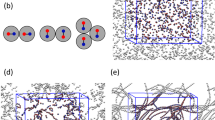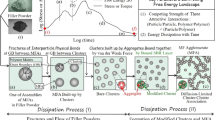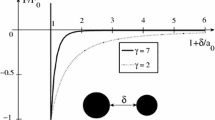Abstract
The connectivity of individual species in a locally heterogeneous granular mixture strongly influences assembly-scale behavior. A behavioral transition is observed at the percolation threshold for a given constituent; that is, the mixing fraction at which the constituent has statistical connectivity between two opposing boundaries. This behavior is particularly evident in conductivity phenomena, e.g., the percolation of conductive particles (thermal, electric) or the relative degree of connectivity of the void space (hydraulic). Hard-core (first nearest-neighbor or lattice) percolation has been extensively studied experimentally, theoretically, and numerically. That hard-core percolation occurs in dense randomly packed bi-phasic mixtures of monodisperse spheres occurs at a mixing fraction of 0.15 v/v is well-accepted. Radiant conduction (e.g., heat), however, is influenced by hard-core “soft-shell” percolation, which is an nth-nearest neighbor problem and less well-studied. In the current work, we use discrete element method simulations coupled with a thermal network model that leverages a robust domain decomposition algorithm to simulate large assemblies of spheres to investigate soft-shell percolation numerically. Our results show that the thermal conductivity of a randomly packed assembly obeys a power law with respect to volume fraction of conductive particles while percolation threshold follows a power law with respect to coordination number. The ability of the pore fluid to transmit heat over a longer distance results in an increase of thermal conductivity and a decrease in thermal percolation threshold. Moreover, we observe that, contrary to previous findings, critical percolation density is not a dimensional invariant and depends on the microstructure of the assembly.















Similar content being viewed by others
References
Agnolin, I., Roux, J.N.: Internal states of model isotropic granular packings. III. Elastic properties. Phys Revi E Stat Nonlin Soft Matter Phys 76(6), 061304 (2007)
Abeles, B., Pinch, H.L., Gittleman, J.I.: Percolation conductivity in W-A12O3 granular metal films. Phys. Rev. Lett. 35(4), 247–250 (1975)
Balberg, I.: Universal percolation-threshold limits in the continuum. Phys. Rev. B 31(6), 4053–4055 (1985)
Balberg, I., Anderson, C.H., Alexander, S., Wagner, N.: Excluded volume and its relation to the onset of percolation. Phys. Rev. B 30(7), 3933–3943 (1984)
Balberg, I., Binenbaum, N.: Computer study of the percolation threshold in a two-dimensional anisotropic system of conducting sticks. Phys. Rev. B 28(7), 3799–3812 (1983)
Balberg, I., Binenbaum, N., Wagner, N.: Percolation thresholds in the three-dimensional sticks system. Phys. Rev. Lett. 52(17), 1465–1468 (1984)
Balberg, I., Bozowski, S.: Percolation in a composite of random stick-like conducting particles. Solid State Commun. 44(4), 551–554 (1982)
Barbero, E.J., Bedard, A.J.: Electrical percolation threshold of magnetostrictive inclusions in a piezoelectric matrix composite as a function of relative particle size. Comput. Part. Mech. 5(2), 227–238 (2017)
Batchelor, G.K., O’Brien, R.W.: Thermal or electrical conduction through a granular material. Proc. Roy. Soc. Lond. A Math. Phys. Sci. Roy. Soc. 355(1682), 313–333 (1977)
Choo, J., Kim, Y.J., Lee, J.H., Yun, T.S., Lee, J., Kim, Y.S.: Stress-induced evolution of anisotropic thermal conductivity of dry granular materials. Acta Geotech. 8(1), 91–106 (2013)
Consiglio, R., Baker, D.R., Paul, G., Stanley, H.E.: Continuum percolation thresholds for mixtures of spheres of different sizes. Physica A 319, 49–55 (2003)
Consiglio, R., Zouain, R.N.A., Baker, D.R., Paul, G., Stanley, H.E.: Symmetry of the continuum percolation threshold in systems of two different size objects. Physica A 343, 343–347 (2004)
Dhar, D.: On the critical density for continuum percolation of spheres of variable radii. Physica A 242(3–4), 341–346 (1997)
Evans, T.M., Lee, J., Yun, T.S., Valdes, J.R.: Thermal conductivity in granular mixtures: experimental and numerical studies. In: International Symposium on Deformation Characteristics of Geomaterials, September 1–3, 2011, Seoul, Korea
Feng, S.: Percolation properties of granular elastic networks in two dimensions. Phys. Rev. B 32(1), 510–513 (1985)
Fitzpatrick, J.P., Malt, R.B., Spaepen, F.: Percolation theory and the conductivity of random close packed mixtures of hard spheres. Phys. Lett. 47A(3), 207–208 (1974)
Frisch, H.L., Sonnenblick, E., Vyssotsky, V.A., Hammersley, J.M.: Critical percolation probabilities (site problem). Phys. Rev. 124(4), 1021–1022 (1961)
He, D., Ekere, N.N.: Effect of particle size ratio on the conducting percolation threshold of granular conductive–insulating composites. J. Phys. D Appl. Phys. 37(13), 1848–1852 (2004)
Itasca Consulting Group, Inc. PFC—Particle Flow Code, Ver. 5.0. Minneapolis: Itasca (2014)
Kirkpatrick, S.: Percolation and conduction. Rev. Mod. Phys. 45(4), 574–588 (1973)
Lee, J.H., Yun, T.S., Choi, S.U.: The effect of particle size on thermal conduction in granular mixtures. Materials 8(7), 3975–3991 (2015)
Lorenz, B., Orgzall, I., Heuer, H.O.: Universality and cluster structures in continuum models of percolation with two different radius distributions. J. Phys. A: Math. Gen. 26(18), 4711–4722 (1993)
Ning, Z., Khoubani, A., Evans, T.M.: Shear wave propagation in granular assemblies. Comput. Geotech. 69, 615–626 (2015)
Ning, Z., Khoubani, A., Evans, T.M.: Particulate modeling of cementation effects on small and large strain behaviors in granular material. Granular Matter 19(1), (2017)
O’Sullivan, C. (2011). Particulate discrete element modelling: A geomechanics perspective. CRC Press
Phanit, M.K., Dhar, D.: Continuum percolation with discs having a distribution of radii. J. Phys. A Math. Gen. 17(12), 645–649 (1984)
Pike, G.E., Seager, C.H.: Percolation and conductivity: a computer study: I. Phys. Rev. B 10(4), 1421–1434 (1974)
Scher, H., Zallen, R.: Critical density in percolation processes. J. Chem. Phys. 53(9), 3759–3761 (1970)
Shante, V.K.S., Kirkpatrick, S.: An introduction to percolation theory. Adv. Phys. 20(85), 325–357 (1971)
Sykes, M.F., Essam, J.W.: Critical percolation probabilities by series methods. Phys. Rev. 133(1A), A310–A315 (1964)
Sykes, M.F., Essam, J.W.: Exact critical percolation probabilities for site and bond problems in two dimensions. J. Math. Phys. 5(8), 1117 (1964)
Yun, T.S., Evans, T.M.: Three-dimensional random network model for thermal conductivity in particulate materials. Comput. Geotech. 37(7–8), 991–998 (2010)
Zallen, R.: The Physics of Amorphous Solids. Wiley-VCH Verlag GmbH & Co. KGaA, Weinheim (2004)
Acknowledgements
The first and second authors (AK and TME) were supported by U.S. National Science Foundation Grant CMMI-1538460 during the course of this work. This support is gratefully acknowledged.
Author information
Authors and Affiliations
Corresponding author
Ethics declarations
Conflict of interest
The authors declare that they have no conflict of interest.
Additional information
Publisher's Note
Springer Nature remains neutral with regard to jurisdictional claims in published maps and institutional affiliations.
Ali Khoubani: Formerly, Graduate Research Assistant, School of Civil and Construction Engineering, Oregon State University.
Rights and permissions
About this article
Cite this article
Khoubani, A., Evans, T.M. & Yun, T.S. Thermal percolation in mixtures of monodisperse spheres. Granular Matter 22, 60 (2020). https://doi.org/10.1007/s10035-020-01028-8
Received:
Published:
DOI: https://doi.org/10.1007/s10035-020-01028-8




